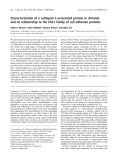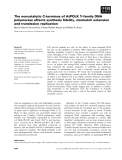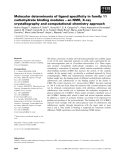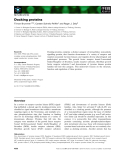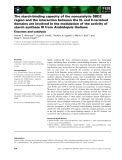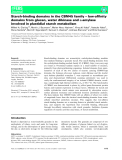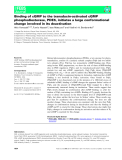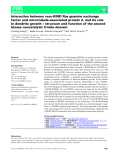
Noncatalytic
-
We reported previously that the major cysteine protease in embryos and larvaeof thebrine shrimp,Artemia franciscana, is a heterodimeric protein consisting of a catalytic subunit (28.5 kDa) with a high degree of homology with cathep-sin L, and a noncatalytic subunit (31.5 kDa) of unknown function. In the study reportedhere thenoncatalytic subunit, or cathepsin L-associated protein (CLAP), was separated from cathepsin L by chromatography on Mono S and found tocontainmultiple isoformswithpIs ranging from5.9 to 6.1.
 12p
12p  awards
awards
 05-04-2013
05-04-2013
 54
54
 4
4
 Download
Download
-
Metallothioneins (MTs) are noncatalytic peptides involved in storage of essential ions, detoxification of nonessential metals, and scavenging of oxyradicals. They exhibit an unusual primary sequence and unique 3D arrangement. Whereas vertebrate MTs are characterized by the well-known dumbbell shape, with abdomain that binds three bivalent metal ions and anadomain that binds four ions, molluscan MT structure is still poorly understood.
 10p
10p  dell39
dell39
 27-03-2013
27-03-2013
 41
41
 4
4
 Download
Download
-
Cell survival depends not only on the ability to repair damaged DNA but also on the capability to perform DNA replication on unrepaired or imperfect templates. Crucial to this process are specialized DNA polym-erases belonging to the Y family. These enzymes share a similar catalytic fold in their N-terminal region, and most of them have a less-well-con-served C-terminus which is not required for catalytic activity.
 11p
11p  galaxyss3
galaxyss3
 19-03-2013
19-03-2013
 36
36
 3
3
 Download
Download
-
The seryl-tRNA synthetase fromSaccharomyces cerevisiaeinteracts with the peroxisome biogenesis-related factor Pex21p. Several deletion mutants of seryl-tRNA synthetase were constructed and inspected for their ability to interact with Pex21p in a yeast two-hybrid assay, allowing mapping of the synthetase domain required for complex assembly.
 12p
12p  galaxyss3
galaxyss3
 19-03-2013
19-03-2013
 42
42
 3
3
 Download
Download
-
The direct conversion of plant cell wall polysaccharides into soluble sugars is one of the most important reactions on earth, and is performed by cer-tain microorganisms such as Clostridium thermocellum(Ct). These organ-isms produce extracellular multi-subunit complexes (i.e. cellulosomes) comprising a consortium of enzymes, which contain noncatalytic carbohy-drate-binding modules (CBM) that increase the activity of the catalytic module.
 12p
12p  media19
media19
 06-03-2013
06-03-2013
 45
45
 4
4
 Download
Download
-
Docking proteins comprise a distinct category of intracellular, noncatalytic signalling protein, that function downstream of a variety of receptor and receptor-associated tyrosine kinases and regulate diverse physiological and pathological processes.
 14p
14p  viettel02
viettel02
 19-02-2013
19-02-2013
 39
39
 4
4
 Download
Download
-
ZF-RNase-3 is one of the RNases from zebrafish (Danio rerio) with special (i.e. noncatalytic) properties. These include angiogenic and bactericidal activities. Given the interest of fish RNases as host-defense effectors, we studied the mechanism of the bactericidal action of ZF-RNase-3 onEscheri-chia coli as a model Gram-negative bacterium.
 8p
8p  mobifone23
mobifone23
 21-01-2013
21-01-2013
 36
36
 4
4
 Download
Download
-
Starch synthase III from Arabidopsis thaliana contains an N-terminal region, including three in-tandem starch-binding domains, followed by a C-terminal catalytic domain. We have reported previously that starch-bind-ing domains may be involved in the regulation of starch synthase III func-tion.
 13p
13p  mobifone23
mobifone23
 18-01-2013
18-01-2013
 46
46
 6
6
 Download
Download
-
Starch-binding domains are noncatalytic carbohydrate-binding modules that mediate binding to granular starch. The starch-binding domains from the carbohydrate-binding module family 45 (CBM45, http://www.cazy.org) are found as N-terminal tandem repeats in a small number of enzymes, primarily from photosynthesizing organisms.
 11p
11p  cosis54
cosis54
 05-01-2013
05-01-2013
 27
27
 3
3
 Download
Download
-
Retinal photoreceptor phosphodiesterase (PDE6), a key enzyme for photo-transduction, consists of a catalytic subunit complex (Pab) and two inhibi-tory subunits (Pcs). Pabhas two noncatalytic cGMP-binding sites. Here, using bovine PDE preparations, we show the role of these cGMP-binding sites in PDE regulation.
 19p
19p  cosis54
cosis54
 05-01-2013
05-01-2013
 44
44
 5
5
 Download
Download
-
The kinase noncatalytic C-lobe domain (KIND) is a putative protein–protein interaction module. Four KIND-containing proteins, Spir-2 (actin-nuclear factor), PTPN13 (protein tyrosine phosphatase), FRMPD2 (scaffold protein) and very-KIND (v-KIND) (brain-specific Ras guanine nucleotide exchange factor), have been identified to date.
 11p
11p  cosis54
cosis54
 05-01-2013
05-01-2013
 36
36
 3
3
 Download
Download
CHỦ ĐỀ BẠN MUỐN TÌM









